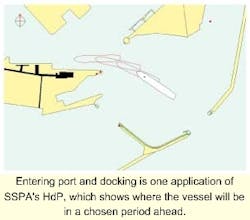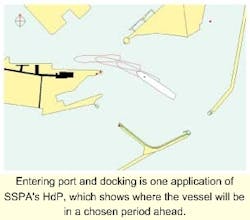SWEDEN Dynamic Positioning: Navigation aid could improve accuracy of vessel maneuvers
The Hydrodynamic Predictor (HdP) developed by SSPA is an advanced navigation aid that allows for continuous prediction of a ship's position, enabling bridge officers to control the ship's course and position more accurately.
The HdP uses an algorithm developed by SSPA which calculates the ship's position, speed, turn-rate, and heading for any period from 30 seconds to 600 seconds ahead. The bridge officer chooses the appropriate time interval. The ship's position is then displayed for the chosen period, and for the two equally spaced intermediate intervals. So if the chosen period is 60 seconds, the position will also be shown for 20 seconds and 40 seconds ahead. The information is normally updated at one-second intervals, but again it is up to the user to select this setting.
The algorithm is applicable to most types of propulsion, and accommodates a wide range of parameters, including rudder angle, propeller rate, bow thruster rate if applicable, wind force and sea depth. As it takes into account the vessel hydrodynamics, for each particular usage a ship definition file containing information on all the parameters for that ship has to be fed in.
"Other predictors take some of the same parameters into account, but I don't know of any that take as many into account as the HdP," says Karl-Johan Raggl, Vice President for SSPA's software division. "The HdP is therefore, in our opinion, far more accurate than other predictors." Tests carried out with a Stena HSS 1500 high-speed catamaran ferry showed a high correlation between predicted and actual position, especially at low-speed maneuvering.
Offshore potential
The system has been installed on a number of Stena's high-speed catamarans operating be-tween Sweden and mainland Europe, and SSPA has recently received an order to supply it to US-based Polar Tankers. It is also in talks with a supplier of integrated bridge systems, which is interested in incorporating the HdP in its systems.
Different periods of prediction are appropriate for different ship types, says Raggl. A shorter period, perhaps 30 seconds, is appropriate for a ferry using the system to enter port and dock. For a tanker which has a much slower maneuvering speed, a longer prediction period, say 250-300 seconds, would be appropriate.
The ability to see your future position is useful in many situations, says Raggl. In an offshore context, one obvious application would be a supply ship approaching a fixed platform, or a shuttle tanker approaching a loading or unloading buoy. It could also be used as a backup for dynamic positioning systems, with the settings being chosen to keep the vessel in the desired position while in transit. In the event of the failure of the DP system, HdP could be used for stationkeeping.
It could also be used in situations where two moving vessels are approaching each other, for example, lightering operations, or when a supply vessel is approaching a floating platform. In this case, both vessels would need to have the system, with the display from both made available on the maneuvering vessel. Work is also under way on a three-dimensional predictor which could be used, for example, to direct a helicopter approaching to land on a platform.
For more information contact Karl-Johan Raggl, SSPA: tel: +46 31 772 9000, fax: +46 31 772 9124, e-mail: [email protected].

